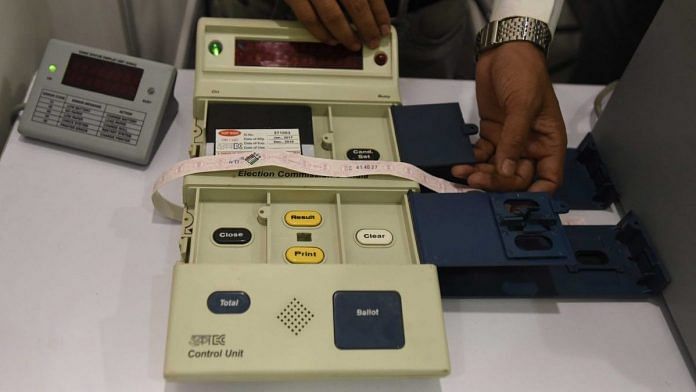With Monday’s bypolls seeing complaints of EVM malfunctioning, ThePrint explains the journey behind the making, installing and destroying of EVMs.
New Delhi: As bypolls took place across for four Lok Sabha seats, and 10 assembly seats in as many states Monday, complaints of electronic voting machines (EVMs) malfunctioning began surfacing. Most prominent among them were from Palghar and Bhandara-Gondia in Maharashtra and from Kairana and Noorpur in Uttar Pradesh.
A complaint by the candidate of the Rashtriya Lok Dal and Samajwadi Party (SP) to the Election Commission, 200 EVMs malfunctioned in the first three hours of polling. The election panel responded to these allegations saying they were “an exaggerated projection of reality”. However, many, including former union minster Praful Patel, raised concerns over the genuineness of the machines.
This isn’t the first time that EVMs have come under scrutiny. ThePrint explains the journey behind the making, installing and destroying of EVMs, from the factory to the voting booths.
The manufacturing process
According to the Election Commission, only two PSUs manufacture EVMs in India — Bharat Electronics Ltd (BEL) and Electronics Corporation of India Ltd (ECIL). Only a few selected engineers are given access to the source code but they are not given any information about the constituency-wise deployment of machines, which takes place later. The EVMs consist of two kinds of units, including the control unit, which is kept with the presiding officer of a polling booth, and the ballot unit, which is used by the voters, to cast their votes by pressing the button.
Evolution of EVMs
Since 1989, there have been three models of EVMs used during elections. Model M1 was manufactured from 1989 to 2006; over 9.2 lakh of these are still functional. Model M2 was manufactured from 2006 to 2012 and came with dynamic coding and a real-time clock to ensure extra security. The latest M3 model introduced in 2013 comes with a tamper-proof feature so that the device stops functioning when accessed without authorisation.
Deployment and transportation
According to the Election Commission, EVMs are transported from the factories to the district headquarters under tight security measures, similar to those taken while transporting cash through RBI. There is minimum stoppage along the way. They are then stored in strong rooms in the district electoral office. There is a double lock system in place, the keys to which are kept with the district electoral officer and the additional district electoral officer. Technical and physical checking of the EVMs are then done by BEL/ECIL engineers in front of representatives of political parties in a hall ahead of the elections. Entry to this hall is restricted, with no cameras or mobile phones allowed inside. Faulty EVMs are sent back to the factory.
Mock voting
Mock voting is performed to test the legitimacy of the EVMs. Five per cent of EVMs are chosen at random by representatives of political parties to perform the first level of checking. Then, a computerised randomisation of EVMs is done twice. The second mock test is performed with the same method once the candidates are declared after the nomination process is over. A final round of mock test is performed in front of the polling agents on the election day, just before the voting process begins, according to EC.
After the polls
The presiding officer presses the ‘close’ button on the control unit once the polls are over. The polling agents then seal these EVMs and put their signatures on the seal. They are then stored in strong rooms with 24-hour security until the counting begins. Political candidates are also allowed to put their own seals on the strong rooms or monitor the entrance to these strong rooms.
Destroying EVMs
The EVMs have a life of 15 years after which they are destroyed. Chips containing the code of the EVMs need to be crushed in the presence of an officer of the Election Commission. Both the control unit and ballot unit are also crushed.



